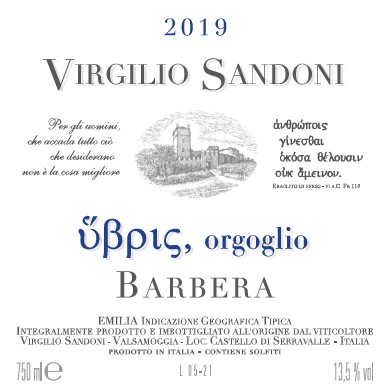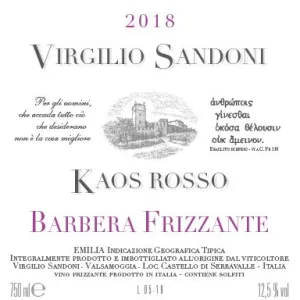-
 UBRIS“Ubris”: why? It definitely takes a good dose of pride to keep on making wine today. Winemaking is an ancient art and is considered by many, part of archaeology. All the more so when one is using a traditional vine, so, no matter how noble, the wine is almost snubbed or not considered at the level of other more modern, more international ones. A double challenge therefore: to make wine with an unfashionable vine and to do it well; so well as to redeem it and hope that my hard work will be appreciated. All classical Greek literature refers to "hubris" not only as pride but also the wish to transcend the limits, to test oneself with a certain "arrogance" or even 'audacity', hoping, obviously, to obtain the excellent result of an 'important' wine to drink everyday, which we feel we have done.
UBRIS“Ubris”: why? It definitely takes a good dose of pride to keep on making wine today. Winemaking is an ancient art and is considered by many, part of archaeology. All the more so when one is using a traditional vine, so, no matter how noble, the wine is almost snubbed or not considered at the level of other more modern, more international ones. A double challenge therefore: to make wine with an unfashionable vine and to do it well; so well as to redeem it and hope that my hard work will be appreciated. All classical Greek literature refers to "hubris" not only as pride but also the wish to transcend the limits, to test oneself with a certain "arrogance" or even 'audacity', hoping, obviously, to obtain the excellent result of an 'important' wine to drink everyday, which we feel we have done. -
 CHARDONNAY IGTThis is a wine with strong varietal characteristics, notes of exotic fruit, particularly pineapple and dry fruit, it’s a fine, rich wine with a fruity and floral bouquet, elegant and harmoniously warm, persistent and well structured through complex perfumes. Even though more suitable for appetizers and delicate, fragrant dishes, because of its consistence, it accompanies well more demanding and important courses.
CHARDONNAY IGTThis is a wine with strong varietal characteristics, notes of exotic fruit, particularly pineapple and dry fruit, it’s a fine, rich wine with a fruity and floral bouquet, elegant and harmoniously warm, persistent and well structured through complex perfumes. Even though more suitable for appetizers and delicate, fragrant dishes, because of its consistence, it accompanies well more demanding and important courses. -
 PIGNOLETTO FRIZZANTE DOC EMILIAFrom the vine plant of the same name, symbol of vine growing in the Bolognesi hills, is a pleasantly fruity wine of good persistence both by smell and taste, harmonious, with a light aftertaste slightly bitter, more or less pronounced that can bring to mind sage, but always slender and fresh. All this makes for a pleasant and elegant wine, a good-looking wine in the glass, a pale yellow colour more or less intense according to the ripeness of the grapes, easy to match with a series of delicate and fragrant dishes.
PIGNOLETTO FRIZZANTE DOC EMILIAFrom the vine plant of the same name, symbol of vine growing in the Bolognesi hills, is a pleasantly fruity wine of good persistence both by smell and taste, harmonious, with a light aftertaste slightly bitter, more or less pronounced that can bring to mind sage, but always slender and fresh. All this makes for a pleasant and elegant wine, a good-looking wine in the glass, a pale yellow colour more or less intense according to the ripeness of the grapes, easy to match with a series of delicate and fragrant dishes. -
 PIGNOLETTO FERMO DOC EMILIAMore austere compared to the semi sparkling version, generally endowed with greater consistency both through the senses of smell and taste, it however recaptures the flavour of the vegetable notes. Richer in components and structure, it does not lose the pleasant fragrance of hawthorn nor diminishes in freshness even though generally being obtained from the more mature grape
PIGNOLETTO FERMO DOC EMILIAMore austere compared to the semi sparkling version, generally endowed with greater consistency both through the senses of smell and taste, it however recaptures the flavour of the vegetable notes. Richer in components and structure, it does not lose the pleasant fragrance of hawthorn nor diminishes in freshness even though generally being obtained from the more mature grape -
 BARBERA FRIZZANTE IGT EMILIAForever present in the Bolognesi hills, it practically was the only noble red before the arrival of other vine plants, such as Cabernet Sauvignon and Merlot, not finding comparison to Sangiovese and Lambrusco (not present in the region). It was, therefore, the important wine of the festive meal, almost always made up of an hors d’oeuvre of assorted traditional pork meats, tortellini in broth, mixed boiled meats and roasts. Generally it was a matter of sparkling dry wine, of lovely violet colours, fragrant and with tannins to the right extent, scented and harmonious. A little less widespread and appreciated is the still version, more or less aged in wood, with intense notes of highly developed tannin, full-bodied and of a colour tending towards garnet. After a period of unjust oblivion, Barbera is always gaining more respectful admirers and one can, with good reason, think that it is one of the most important wines of the area, from which it is right to wait for more surprising developments. Both in the ‘still’ version and the sparkling, it goes very well with the majority of culinary dishes in the area, both snacks based on pork meats and tasty cheese and more important dishes made up of well-seasoned pasta and generous and nourishing meat courses. If well matured, and not too dry, it can also be served with traditional desserts and cakes
BARBERA FRIZZANTE IGT EMILIAForever present in the Bolognesi hills, it practically was the only noble red before the arrival of other vine plants, such as Cabernet Sauvignon and Merlot, not finding comparison to Sangiovese and Lambrusco (not present in the region). It was, therefore, the important wine of the festive meal, almost always made up of an hors d’oeuvre of assorted traditional pork meats, tortellini in broth, mixed boiled meats and roasts. Generally it was a matter of sparkling dry wine, of lovely violet colours, fragrant and with tannins to the right extent, scented and harmonious. A little less widespread and appreciated is the still version, more or less aged in wood, with intense notes of highly developed tannin, full-bodied and of a colour tending towards garnet. After a period of unjust oblivion, Barbera is always gaining more respectful admirers and one can, with good reason, think that it is one of the most important wines of the area, from which it is right to wait for more surprising developments. Both in the ‘still’ version and the sparkling, it goes very well with the majority of culinary dishes in the area, both snacks based on pork meats and tasty cheese and more important dishes made up of well-seasoned pasta and generous and nourishing meat courses. If well matured, and not too dry, it can also be served with traditional desserts and cakes